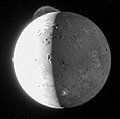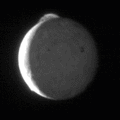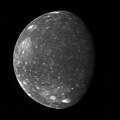Ficheiro:NewHorizonsIo.jpg
NewHorizonsIo.jpg (330 × 326 píxeis, tamanho: 24 kB, tipo MIME: image/jpeg)
Histórico do ficheiro
Clique uma data e hora para ver o ficheiro tal como ele se encontrava nessa altura.
| Data e hora | Miniatura | Dimensões | Utilizador | Comentário | |
|---|---|---|---|---|---|
| atual | 23h36min de 22 de dezembro de 2022 |  | 330 × 326 (24 kB) | Ras67 | == {{int:filedesc}} == {{Information |Description={{en|1=Image of Io taken by New Horizons on February 28, 2007. * This dramatic image of Io was taken by the Long Range Reconnaissance Imager (LORRI) on New Horizons at 11:04 Universal Time on February 28, 2007, just about 5 hours after the spacecraft's closest approach to Jupiter. The distance to Io was 2.5 million kilometers (1.5 million miles) and the image is centered at 85 degrees west longitude. At this distance, one LORRI pixel subtends... |
Utilização local do ficheiro
As seguintes 2 páginas usam este ficheiro:
Utilização global do ficheiro
As seguintes wikis usam este ficheiro:
- af.wikipedia.org
- en.wikipedia.org
- hr.wikipedia.org
- it.wikipedia.org
- ko.wikipedia.org
- lt.wikipedia.org
- no.wikipedia.org
- sh.wikipedia.org
- th.wikipedia.org
- vi.wikipedia.org
- zh.wikipedia.org











